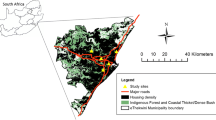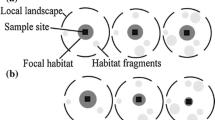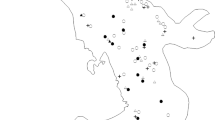Abstract
Context
Theory predicts that species diversity of isolated habitat patches depends on patch size and isolation. However, there are few previous studies of how patch size and isolation influence community composition. This study tested theory using small and isolated farmland patches in a forested matrix.
Objectives
I tested whether bird species diversity and community composition of isolated farmland patches depended on patch size, measures of isolation (e.g. distance from the main farmland areas; up to 15 km), and other variables such as presence of human habitation.
Methods
Farmland bird species diversity and community composition (relative proportions of different ecological guilds) of 130 farmland patches within forest landscapes were recorded in Norway.
Results
Species diversity and proportion of the species that nested on the ground or low in bushes increased with patch size. Distance from the main farmland region was not related to species diversity or community composition, but species diversity increased when there were stepping stones present. Sites inhabited by humans had higher species diversity, a larger proportion of species nesting high in trees or in cavities (such as in buildings), and a larger proportion of resident species. Other variables were less important. There was also a strong relationship between the occupancy of individual species in the main farmland region and their occupancy in the forest region, suggesting that colonisation pressure also influenced species diversity of these habitat islands.
Conclusions
I found weak evidence of isolation effects on bird species diversity and community composition of farmland patches within forest, whereas most of the variation was explained by patch size and presence of humans.



Similar content being viewed by others
References
Andrén H (1994) Effects of habitat fragmentation on birds and mammals in landscapes with different proportions of suitable habitat: a review. Oikos 71:355–366
Andrén H, Angelstam P (1988) Elevated predation rates as an edge effect in habitat islands: experimental evidence. Ecology 69:544–547
Askins RA, Philbrick MJ, Sugeno DS (1987) Relationship between the regional abundance of forest and the composition of forest bird communities. Biol Conserv 39:129–152
Bélichon S, Clobert J, Massot M (1996) Are there differences in fitness components between philopatric and dispersing individuals? Acta Oecol 17:503–517
Bélisle M, Desrochers A (2002) Gap-crossing decisions by forest birds: an empirical basis for parameterizing spatially-explicit, individual-based models. Landscape Ecol 17:219–231
Bélisle M, Desrochers A, Fortin M-J (2001) Influence of forest cover on the movements of forest birds: a homing experiment. Ecology 82:1893–1904
Bender DJ, Contreras TA, Fahrig L (1998) Habitat loss and population decline: a meta-analysis of the patch size effect. Ecology 79:517–533
Brotons L, Mönkkönen M, Martin JL (2003) Are fragments islands? Landscape context and density–area relationship in boreal forest birds. Am Nat 162:343–357
Dale S (2001) Female-biased dispersal, low female recruitment, unpaired males, and the extinction of small and isolated bird populations. Oikos 92:344–356
Dale S (2018) Urban bird community composition influenced by size of urban green spaces, presence of native forest, and urbanization. Urban Ecosyst 21:1–14
Dale S, Andersen GS, Eie K, Bergan M, Stensland P (2001) Guide til fuglelivet i Oslo og Akershus. Norsk Ornitologisk Forening, avdeling Oslo og Akershus, Oslo
Dale S, Lifjeld JT, Rowe M (2015) Commonness and ecology, but not bigger brains, predict urban living in birds. BMC Ecol 15:12
Dale S, Steifetten Ø, Osiejuk TS, Losak K, Cygan JP (2006) How do birds search for breeding areas at the landscape level? Interpatch movements of male ortolan buntings. Ecography 29:886–898
Donald PF, Green RE, Heath MF (2001) Agricultural intensification and the collapse of Europe’s farmland bird populations. Proc R Soc Lond B 268:25–29
Ewers RM, Didham RK (2006) Confounding factors in the detection of species responses to habitat fragmentation. Biol Rev 81:117–142
Fahrig L (2007) Non-optimal animal movement in human-altered landscapes. Funct Ecol 21:1003–1015
Ferraz G, Nichols JD, Hines JE, Stouffer PC, Bierregaard ROJ, Lovejoy TE (2007) A large-scale deforestation experiment: effects of patch area and isolation on Amazon birds. Science 315:238–241
Ford HA (1987) Bird communities on habitat islands in England. Bird Stud 34:205–218
Haavik A, Dale S (2012) Are reserves enough? Value of protected areas for boreal forest birds in southeastern Norway. Ann Zool Fenn 49:69–80
Haftorn S (1971) Norges Fugler. Universitetsforlaget, Oslo
Heldbjerg H, Sunde P, Fox AD (2018) Continuous population declines for specialist farmland birds 1987–2014 in Denmark indicates no halt in biodiversity loss in agricultural habitats. Bird Conserv Int 28:278–292
Kålås JA, Dale S, Gjershaug JO, Husby M, Lislevand T, Strann K-B, Strøm H (2015) Norwegian Red List for Species 2015. Birds Aves. Norwegian Biodiversity Information Centre, Trondheim
Kupfer JA, Malanson GP, Franklin SB (2006) Not seeing the ocean for the islands: the mediating influence of matrix-based processes on forest fragmentation effects. Glob Ecol Biogeogr 15:8–20
Laurance WF (2008) Theory meets reality: how habitat fragmentation research has transcended island biogeographic theory. Biol Conserv 141:1731–1744
Laurance WF, Camargo JLC, Luizão RCC, Laurance SG, Pimm SL, Bruna EM, Stouffer PC, Williamson GB, Benítez-Malvido J, Vasconcelos HL (2011) The fate of Amazonian forest fragments: a 32-year investigation. Biol Conserv 144:56–67
Lomolino MV, Brown JH, Davis R (1989) Island biogeography of montane forest mammals in the American Southwest. Ecology 70:180–194
Lynch JF, Whigham DF (1984) Effects of forest fragmentation on breeding bird communities in Maryland, USA. Biol Conserv 28:287–324
MacArthur RH, Wilson EO (1963) An equilibrium theory of insular zoogeography. Evolution 17:373–387
MacArthur RH, Wilson EO (1967) The theory of island biogeography. Princeton University Press, Princeton
Mazerolle MJ, Villard M-A (1999) Patch characteristics and landscape context as predictors of species presence and abundance: a review. Ecoscience 6:117–124
Moore NW, Hooper MD (1975) On the number of species in British woods. Biol Conserv 8:239–250
Moore RP, Robinson WD, Lovette IJ, Robinson TR (2008) Experimental evidence for extreme dispersal limitation in tropical forest birds. Ecol Lett 11:960–968
Morgado R, Beja P, Reino L, Gordinho L, Delgado A, Borralho R, Moreira F (2010) Calandra lark habitat selection: strong fragmentation effects in a grassland specialist. Acta Oecol 36:63–73
Newton I (2004) The recent declines of farmland bird populations in Britain: an appraisal of causal factors and conservation actions. Ibis 146:579–600
Nielsen AB, van den Bosch M, Maruthaveeran S, van den Bosch CK (2014) Species richness in urban parks and its drivers: a review of empirical evidence. Urban Ecosyst 17:305–327
Nilsson SG (1986) Are bird communities in small biotope patches random samples from communities in large patches? Biol Conserv 38:179–204
Nores M (1995) Insular biogeography of birds on mountain-tops in North Western Argentina. J Biogeogr 22:61–70
Opdam P, Rijsdijk G, Hustings F (1985) Bird communities in small woods in an agricultural landscape: effects of area and isolation. Biol Conserv 34:333–352
Orell M (1989) Population fluctuations and survival of great tits Parus major dependent on food supplied by man in winter. Ibis 131:112–127
Prevedello JA, Vieira MV (2010) Does the type of matrix matter? A quantitative review of the evidence. Biodivers Conserv 19:1205–1223
Prugh LR, Hodges KE, Sinclair ARE, Brashares JS (2008) Effect of habitat area and isolation on fragmented animal populations. Proc Natl Acad Sci USA 105:20770–20775
Reino L, Beja P, Osborne P, Morgado R, Fabiao A, Rotenberry JT (2009) Distance to edges, edge contrast and landscape fragmentation: interactions affecting farmland birds around forest plantations. Biol Conserv 142:824–838
Ricketts TH (2001) The matrix matters: effective isolation in fragmented landscapes. Am Nat 158:87–99
Robb GN, McDonald RA, Chamberlain DE, Bearhop S (2008) Food for thought: supplementary feeding as a driver of ecological change in avian populations. Front Ecol Environ 6:476–484
Saunders DA, Hobbs RJ, Margules CR (1991) Biological consequences of ecosystem fragmentation: a review. Conserv Biol 5:18–32
Soulé ME, Alberts AC, Bolger DT (1992) The effects of habitat fragmentation on chaparral plants and vertebrates. Oikos 63:39–47
Thornton DH, Branch LC, Sunquist ME (2011) The influence of landscape, patch, and within-patch factors on species presence and abundance: a review of focal patch studies. Landsc Ecol 26:7–18
van Dorp D, Opdam PFM (1987) Effects of patch size, isolation and regional abundance on forest bird communities. Landscape Ecol 1:59–73
Watling JI, Donnelly MA (2006) Fragments as islands: a synthesis of faunal responses to habitat patchiness. Conserv Biol 20:1016–1025
Zollner PA (2000) Comparing the landscape level perceptual abilities of forest sciurids in fragmented agricultural landscapes. Landsc Ecol 15:523–533
Zollner PA, Lima SL (1997) Landscape-level perceptual abilities in white-footed mice: perceptual range and the detection of forested habitat. Oikos 80:51–60
Acknowledgements
I thank Roar Økseter for help with producing maps, and Geir A. Sonerud and two anonymous reviewers for comments on the manuscript.
Author information
Authors and Affiliations
Corresponding author
Ethics declarations
Conflict of interest
The author declares that he has no conflict of interest.
Additional information
Publisher's Note
Springer Nature remains neutral with regard to jurisdictional claims in published maps and institutional affiliations.
Electronic supplementary material
Below is the link to the electronic supplementary material.
Rights and permissions
About this article
Cite this article
Dale, S. Islands in the forest: effects of patch size and isolation on farmland bird species richness and community composition of farmland patches in forest landscapes. Landscape Ecol 34, 2823–2836 (2019). https://doi.org/10.1007/s10980-019-00920-w
Received:
Accepted:
Published:
Issue Date:
DOI: https://doi.org/10.1007/s10980-019-00920-w




